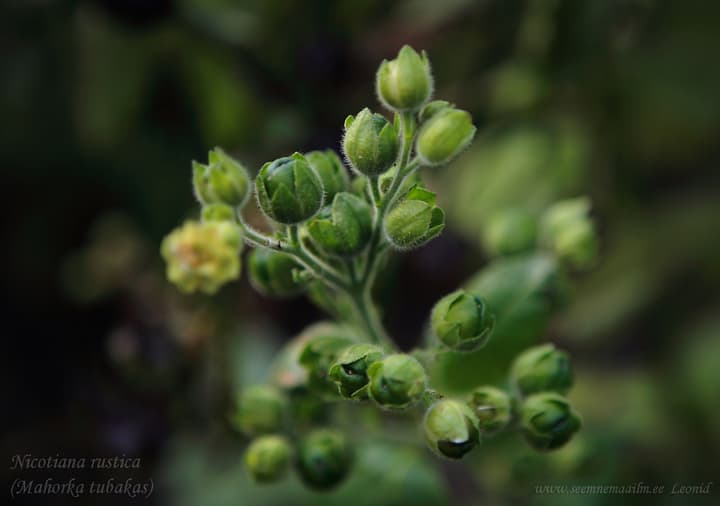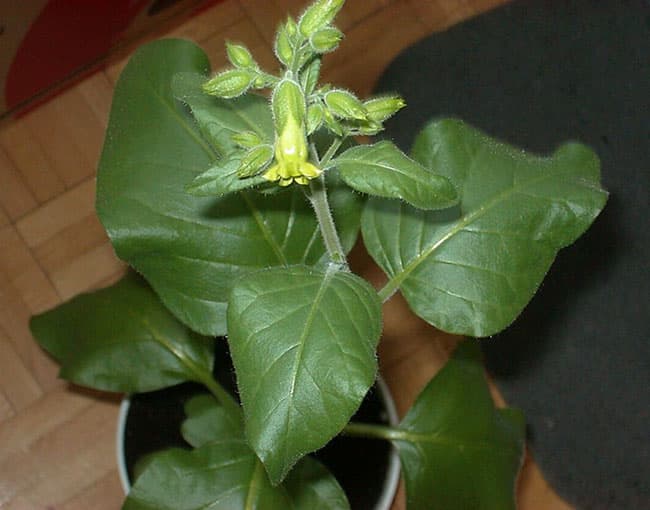A healer for garden plants!
Wild tobacco is grown to make makhorka (smoking) grits, chewing and snuff tobacco, and to protect plants from pests.
Wild tobacco leaves contain significantly more nicotine (about 5-15%) than most varieties of smoking tobacco.
The plant is heat-loving, prefers loamy or sandy soils, requires constant moisture supply (during drought, the quality of the raw material decreases).
Sowing for seedlings is carried out in late March-April. Before sowing, the container is filled with slightly damp soil (three parts of sandy loam turf soil and one part of well-rotted and sifted humus), the surface is compacted and leveled. The seeds are evenly distributed over the surface, lightly pressed into the substrate, moistened with a spray bottle and covered with film. The crops are placed in a light, warm place, watered through a tray, and aired every day (the film is lifted for 30 minutes).
Young plants are planted in open ground in mid- to late May at a distance of 50-70 cm. When 2-3 flowers in the inflorescence open, topping is carried out (removal of the inflorescence), and some of the upper leaves are removed at the same time. When the lateral shoots grow by 5-7 cm, side shoots are pinched. 8-12 leaves are left on the plant for ripening.
Nicotiana rustica is harvested as whole plants in the phase of technical maturity of the middle tier leaves (30-40 days after topping). Technically mature leaves are characterized by dense tissue, hang down to the ground, become covered with light yellow spots, and become brittle.

Nicotiana rustica is an annual plant of the Solanaceae family.
The root of the Indian tobacco is taproot, strongly developed. The stem is erect, ribbed, with a loose core, up to 1,2 m high. The leaves are petiolate, cordate or ovate, with a wrinkled surface, light or yellow-green in color. There are 12-20 leaves on the stem. The leaves and stems are covered with short capitate hairs that emit a specific smell. The inflorescence is a panicle. The flowers are bisexual, green or yellowish-green, quinquepareal, with bracts.
The Indian tobacco is a self-pollinating plant, but cross-pollination is also observed. The fruit is a bivalve multi-seeded capsule.
The seeds are small, brown or cream-colored. Weight of 1000 seeds = 0,25-0,35 g.
Wild tobacco is grown to obtain smoking (makhorka) grits, snuff and chewing tobacco. The dry leaves of this plant contain 5-15% nicotine and 15-20% organic acids, including 10% or more citric acid. The stems of Indian tobacco contain slightly less of the listed substances. A significant part of the tobacco raw material is used to obtain nicotine (vitamin PP) and citric acids used in the food and textile industries. Fatty oil (35-40%) is obtained from makhorka seeds, used in the production of paints, varnishes and soap.
Indian tobacco is a long-day plant. As you move north, its development accelerates, which makes it possible to grow this crop even in the Arctic. However, in comparison with other long-day crops, it is more thermophilic.
Indian tobacco seeds begin to germinate at a temperature of +7+8°C. The most favorable temperature for growth and development is +20+25°C. Indian tobacco is sensitive to low temperatures and is damaged by frosts of -2-3°C.
The crop requires constant sufficient moisture supply: even with short-term water stress, the quality of the raw material deteriorates.
The best soils for Wild tobacco are loamy chernozems, sandy loam and loamy sod-podzolic soils.
Features of agricultural technology.
The best predecessors of Indian tobacco are winter grains, corn, root crops, legumes, perennial grasses and vegetable crops. Indian tobaccoshould not be planted after melons, potatoes, hemp and sunflowers, which have common diseases and common pests. Wild tobacco is a good predecessor for many field crops.
The plant is demanding of the soil fertility level. To form 1 ton of dry leaves and stems, Makhorka consumes: nitrogen - 24 kg, phosphorus - 10 kg, potassium - 35 kg. A good yield of dry leaves and stems is considered to be 3-3.5 t / ha.

* Smoke tobacco, in comparison with Indian tobacco, is more demanding of heat. It can be grown south of 55 ° north parallel. Indian tobacco is more unpretentious. It grows well from the Arctic to the southern regions of Europe.
A smoker consumes an average of 7.5-8.0 kg of tobacco per year. In favorable conditions, 0.01 ha can yield 30-40 kg of dry tobacco leaves. The weight of one dry leaf is 0.8-1.5 g. The plant produces 25-33 technically mature leaves per season.











